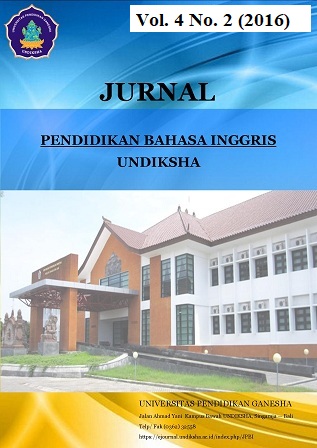THE MORPHOLOGICAL PROCESSES OF BALINESE DIALECT SPOKEN BY BATUMULAPAN VILLAGERS: A DESCRIPTIVE STUDY
DOI:
https://doi.org/10.23887/jpbi.v4i2.9578Abstract
Penelitian ini bertujuan untuk mendeskripsikan afiksasi yang termasuk derivasi dan infleksi dari dialek Batumulapan di Nusa Penida, Kabupaten Klungkung, Propinsi Bali. Penelitian ini merupakan penelitian deskriptif kualitatif. Subjek dari penelitian ini adalah penduduk asli dari dialek tersebut. Subjek dari penelitian ini diambil dengan menggunakan teknik purposive sampling. Data dikumpulkan dengan melaksanakan observasi dan teknik perekaman. Data yang diperolah dikumpulkan dari tiga domain yang berbeda yaitu: domain keluarga, pertemanan dan persahabatan dan dianalisis dengan menggunakan prosedur dari data analisis yang diusulkan oleh Miles dan Huberman, (1984). Objek dari penelitian ini adalah afiksasi dari dialek Batumulapan yang termasuk derivasi dan infleksi. Hasil dari penelitian ini menunjukkan bahwa ada enam jenis awalan di BDBM yaitu: awalan {me-}, {nge-}, {ng-}, {a-}, {ny-}, and {h-}. Ada satu jenis sisipan {-h-}., dan ada lima jenis akhiran di BDBM yaitu: akhiran {-te}, {-an}, {-in}, {-e} and {-ne}. Awalan dan akhiran yang termasuk derivasi di BDBM adalah awalan {me-} dan akhiran {-te}, {-an}, dan {-e}. Awalan dan akhiran yang termasuk infleksi di BDBM adalah awalan {me-}, {nge-}, {ng-}, {ny-}, {a-}, dan {h-}, sisipan {-h-) dan akhiran {-te}, {-an}, {-in}, {-e} and {-ne}.Kata Kunci : Kata-kata kunci: afiksasi, dialek Batumulapan, proses derivasi dan infleksi
This study aimed at describing the affixation which belongs to derivation and inflection of Balinese dialect spoken by Batumulapan villagers (BDBM) in Nusa Penida, Klungkung regency, Bali province. This research was a qualitative descriptive study. The subject of this study was the native speakers of the dialect. The subject was taken through purposive sampling technique. The data were collected by conducting observation and recording technique. The obtained data were collected in three different domains: family, friendship, and neighborhood domain, then analyzed by using the procedure of data analysis suggested by Miles and Huberman, (1984). The object of this study is affixation of BDBM that belongs to derivational and inflectional morpheme. The results of this research show that there are six kinds of prefixes: {me-}, {nge-}, {ng-}, {a-}, {ny-}, and {h-} in BDBM. There is one kind of infix {-h-}., and there are five suffixes: {-te}, {-an}, {-in}, {-e} and {-ne} in BDBM. The prefixes and suffixes which belong to derivation in BDBM include: prefix {me-} and suffix {-te}, {-an}, and {-e}. Prefixes and suffixes in BDBM which belong to inflection include: Prefix {me-}, {nge-}, {ng-}, {ny-}, {a-}.and {h-}, infix {-h-) and suffix {-te}, {-an}, {-in}, {-e} and {-ne}.
keyword : Key Words: affixation, Batumulapan dialect, derivational and inflectional processes
Published
2017-02-28
Issue
Section
Articles
License
Authors who publish with the Jurnal Pendidikan Bahasa Inggris Undiksha agree to the following terms:- Authors retain copyright and grant the journal the right of first publication with the work simultaneously licensed under a Creative Commons Attribution License (CC BY-SA 4.0) that allows others to share the work with an acknowledgment of the work's authorship and initial publication in this journal
- Authors are able to enter into separate, additional contractual arrangements for the non-exclusive distribution of the journal's published version of the work (e.g., post it to an institutional repository or publish it in a book), with an acknowledgment of its initial publication in this journal.
- Authors are permitted and encouraged to post their work online (e.g., in institutional repositories or on their website) prior to and during the submission process, as it can lead to productive exchanges, as well as earlier and greater citation of published work. (See The Effect of Open Access)













